Complete Solutions to EXAMPLE of chapter Classification of Plants of Class 9 book with complete answers and questions
| Class 9 | BIOLOGY |
| Chapter | Classification of Plants |
| CHETANA PUBLICATION | EXAMPLE |
| Number Of Questions | 100 |
| Academic Year | 2023-24 |
How living organisms have been classified?
View SolutionThe five kingdom classification was proposed by……
View SolutionIn 1883,…….classified plants into two sub-kingdoms.
View SolutionUlothrix, ulva,sargassum belong to…….
View Solution……...is a bryophyte.
View SolutionIn…..the seeds are naked.
View SolutionIn…...the flowers are reproductive organs.
View SolutionIn…..the flowers are tetramerous or pentamerous.
View SolutionIn monocotyledonous plants, the stem is……
View SolutionLycopodium belongs to……..
View SolutionLeaves of ………..show reticulate venation.
View SolutionVarious types of fungi like yeasts and moulds are included in the group
View SolutionBryophytes have root-like structure called…………..
View Solution………reproduce with the help of spores formed along the back or posterior surface of their leaves.
View SolutionIn…...the reproductive organs cannot be seen.
View Solution…….are mostly evergreen, perennial and woody
View SolutionGymnosperms bear male and female flowers on different ……… of the same plant.
View SolutionIn…….the seeds are not enclosed by fruit.
View SolutionIn…….the seeds are enclosed by fruit.
View SolutionThe plants whose seeds cannot be divided into equal parts are called……..
View SolutionThe plants whose seeds can be divided into equal parts are called……
View SolutionFind the odd one out:
Ulothrix, Ulva, Nephrolepis, Sargassum
View SolutionFind the odd one out:
Funaria, Marchantia, Anthoceros, Spirogyra
View SolutionFind the odd one out:
Marsilea, Pteris, Lycopodium, Riccia
View SolutionFind the odd one out:
Cycas, Mango, Apple, Banyan
View SolutionFind the odd one out:
Onion, Rice, Wheat, Green peas
View SolutionComplete the analogy:
Spirogyra :Thallophyta :: Riccia :……
View SolutionComplete the analogy:
Moss:Bryophyta ::Selaginella…..
View SolutionComplete the analogy:
Nephrolepis: Pteridophyta :: Ulothrix :……..
View SolutionComplete the analogy:
Pteridophyta :Roots::Bryophyta…….
View SolutionComplete the analogy:
Gymnosperms: naked seeds::Angiosperms:…….
View SolutionComplete the analogy:
Dicotyledon : Reticulate venation :Monocotyledon :….
View SolutionComplete the analogy:
Bamboo stem:Hollow::OnionStem:……
View SolutionComplete the analogy:
Monocotylendon :Fibrous root :: Dicotyledon :………
View SolutionDistinguish between the following:
Thallphyta and Bryophyta.
View SolutionDistinguish between the following:
Gymnosperms and Angiosperms.
View SolutionDifference between:
Algae and Moss
View SolutionState whether the following statements are true or false. Correct the false statements:
Thallophyta are called as the amphibians of the plant Kingdom.
View SolutionState whether the following statements are true or false. Correct the false statements: Fungi like yeasts and moulds are included in division bryophyta.
View SolutionState whether the following statements are true or false. Correct the false statements:
Moss (Funaria) belongs to division bryophyta
View SolutionState whether the following statements are true or false. Correct the false statements:
Bryophyta have specific tissues for conduction of food and water
View SolutionState whether the following statements are true or false. Correct the false statements:
Plants belonging to Thallophyta group are only unicellular
View SolutionState whether the following statements are true or false. Correct the false statements:
Pteridophytes have well developed roots, stems and leave
View SolutionState whether the following statements are true or false. Correct the false statements:
Pteridophytes reproduce with the help of spores formed along the back or posterior surface of their leaves
View SolutionState whether the following statements are true or false. Correct the false statements:
Nephrolepis belongs to division Pteridophyta.
View SolutionState whether the following statements are true or false. Correct the false statements:
Depending upon whether seeds are enclosed in a fruit or not, phanerogams are classified into monocots and dicots.
View SolutionState whether the following statements are true or false. Correct the false statements:
Gymnosperms are mostly evergreen, perennial and woody
View SolutionState whether the following statements are true or false. Correct the false statements:
Gymnosperms bear male and female flowers on different sporophylls of different plants
View SolutionState whether the following statements are true or false. Correct the false statements:
In Angiosperms, the seeds are covered by fruits.
View SolutionState whether the following statements are true or false. Correct the false statements:
Dicotyledonous plants show reticulate venation
View SolutionState whether the following statements are true or false. Correct the false statements:
Moncotyledonous plants have trimerous flowers.
View SolutionState whether the following statements are true or false. Correct the false statements:
In dicotyledonous plants, the stem is strong and hard
View SolutionWhat are ornamental plants are called?
View SolutionPlants with two cotyledons are called.
View SolutionPlants with single cotyledon are called.
View SolutionType of venation showed by hibiscus plant leaves
View SolutionType of venation showed by lily plant leaves
View Solution…….are mostly evergreen, perennial and woody
View SolutionWhich type of venation showed by dicot plants?
View SolutionWhich type of venation showed by monocot plants?
View SolutionHow are angiosperms classified into monocot and dicot?
View SolutionWhere do gymnosperms bear their male and female flowers?
View SolutionIn which division are fungi like moulds and yeast classified?
View SolutionPlants belonging to which group may be unicellular or multicellular?
View SolutionComplete the sentences and explain them:
(Angiosperms, gymnosperms, spores, bryophyta, thallophyta, zygote)
…………is called the 'amphibian' of the plant kingdom.
View SolutionThallophyta plants have thin and fibre like body.
View SolutionBryophute plants are called amphibian plant.
View SolutionState whether the following statements are true or false. Correct the false statements:
Gymnosperms bear male and female flowers on different sporophylls of different plants
View SolutionIn Pteridophytes, asexual reproduction occurs by spore formation and sexual reproduction occurs by zygote formation.
View SolutionWrite note on
August W. Eichler
View SolutionWrite note on
Thallophyta
View SolutionWrite note on
Bryophyta
View SolutionWrite note on
Pteridophyta
View SolutionWrite note on
Phanerogams
View SolutionWrite note on
Gymnosperms
View SolutionWrite note on
Angiosperms
View SolutionLiving Organisms
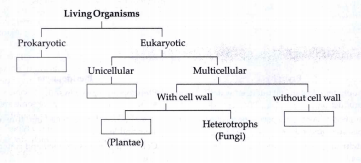
View SolutionKingdom: Plantae

View SolutionDistinguish between Bryophyta and Pteridophyta.
View SolutionDistinguish between:
Angiosperms and Gymnosperms
View SolutionDistinguish between cryptogams and phanerogams.
View SolutionDistinguish between:
Dicots and Monocots
View SolutionDistinguish between Bryophyta and Pteridophyta.
View SolutionDistinguish between Bryophyta and Pteridophyta.
View SolutionDistinguish between:
Angiosperms and Gymnosperms
View SolutionDistinguish between:
Angiosperms and Gymnosperms
View SolutionDistinguish between Dicotyledonae and Monocotyledonae.
View SolutionDistinguish between anatomy of Dicot and Monocot roots.
View SolutionAnswer the following questions:
Sketch , label and describe Spirogyra.
View SolutionAnswer the following questions:
Sketch and label the figures of the following and explain them in brief.
Marchantia
View SolutionAnswer the following questions:
Sketch and label the figures of the following and explain them in brief.
Fern
View SolutionDicot Plants
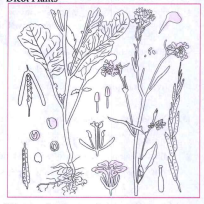 What are the characteristics of the above plants in terms of root system?
What are the characteristics of the above plants in terms of root system?
View SolutionDicot Plants
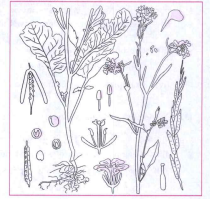
What are the characteristics of the above plants in terms of flowers?
View SolutionDicot Plants

What are the characteristics of the abvoe plants in terms of leaf venations?
View SolutionDicot Plants
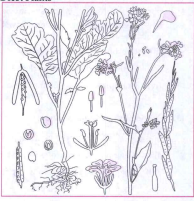
What are the characterisitcs of the above plants in terms of type of stem?
View SolutionDicot Plants

What are the characteristics of the above plants in terms of seed?
View SolutionDicot Plants

Give example of the following types of plants.
View SolutionMonocot Plants
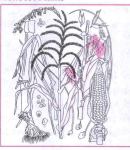
What are the characteristics of the above plants in terms of root system.
View SolutionMonocot Plants

What are the characteristics of the above plants in terms of flowers?
View SolutionMonocot Plants
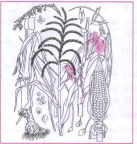
What are the characteristics of the above plants in terms of leaf venations?
View Solution
EXAMPLE questions and complete solutions for chapter Classification of Plants of CHETANA PUBLICATION of Class 9